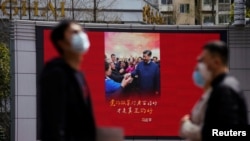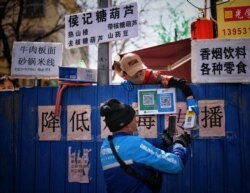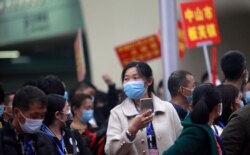The number of coronavirus infections was still surging and the peak was yet to come. That was when China made a seemingly inconceivable call in early February: Everyone should go back to work.
On the day the order was issued by departments of the central government in Beijing, there were 4,214 cases reported across China. Five days later, on February 12, the number of cases reported in China jumped to more than 14,000, the country's single biggest increase.
Since then, tens of millions of people have returned to office desks and factory floors across the country. But the local infections have plummeted. On the last four days, Hubei province, the center of the outbreak, has reported no new local infections.
There are many reasons to be skeptical of China's reported infections. The government has a reputation for tightly controlling information, especially information about its performance. Some health experts caution against accepting Beijing's figures at face value but others, including World Health Organization chief Tedros Adhanom Ghebreyesus, insist China's record in combating the pandemic, "provides hope for the rest of the world."
Here's how China is getting its factories back online, and why the system could be hard to emulate elsewhere.
High-tech code, low-tech paper
As the country was slowly relaxing its quarantines and lockdowns, it faced an obvious question: How do they know who is healthy and who is not?
One of China's tech giants helped provide an answer. The city of Hangzhou, where Alibaba is based, launched a health system developed by the company on February 9, which assigns each citizen an individual color-coded QR code based on their risk profile that determines whether they need to self-quarantine.
Those with yellow and red codes are not allowed out for certain days and are required to log in every day during quarantine before their codes can turn green.
Now the system, which is accessed both through China's popular Alibaba's Alipay and Tencent's WeChat apps, can cover almost the entire country, according to a statement release by the government last Friday.
That has quickly turned the system into almost an official travel permit within China. Everything from gaining access to an apartment building or riding public transportation can require people to submit their QR code for scanning.
"Going out of residential buildings to take a bus or train, it requires health code," said Zhang Yi, a resident of Wuhan, the city at the epicenter of the outbreak. "For example, when I wanted to go out today, at the entrance they asked me to show my health code."
While high-tech solutions are being embraced, the country has not forgotten its century-old paper and stamp. In addition to health QR code, migrant workers who want to go out for work have to obtain a paper "Health Certificate" from their local authorities to travel.
It is a lengthy process. First, they need to have a physical exam from a local doctor in the community. After a doctor signs off, the village committee, township government and health center need to stamp and sign the form. Local media reported that in many places, people who apply for the certificates at township health centers often have to wait hours in lines.
'Point-to-point' chartered transportation
During the lockdown, Chinese migrant workers, mostly from the under-developed rural areas, were stranded. Roadblocks and checkpoints set up throughout the country prevented residents from even visiting neighboring villages.
These checkpoints helped stem the outbreak, but left millions of workers far from their jobs. The government was desperate to get them back to work, but also didn't want to risk igniting a new outbreak.
After weighing up the cost and efficiency of various transportation options, governments across China proposed a plan to move the workers and minimize risk.
The system relies on arranged so-called "point-to-point" direct chartered transportation. Authorities are organizing high-speed trains, long distance buses, or even aircraft flights to pick up the workers in the interior provinces and take them back to the factories in mostly coastal cities.
After they arrive near their job sites, workers line up for temperature checks, disinfection and nucleic acid tests again as health workers collect swabs from the new arrivals. The workers are then guided to quarantined rooms, or in some cases government provided hotels, to wait for test results. In some areas, even if the results come back negative, workers still must remain quarantined for at least another week before allowed to return to their job.
According to data released by the Ministry of Human Resources and Social Security last Thursday, 160,000 special trains, 1,292 chartered buses, and 514 charter flights have been organized in various provinces. China's official news agency says the system has allowed more than 100 million migrant workers to return to work.
Is China's cure the answer?
Chinese approaches to managing the pandemic could be difficult to replicate in countries with stronger legal rights for individuals as well as protections for privacy.
A New York Times analysis of the QR health code found that the system appears to share information with the police. Others complained in the Chinese social media about the alarm signals connected to police stations that show if someone in quarantine has gone out.
For people like Zhang Yi, the Wuhan resident who also happens to be a government critic, the QR code system and other heavy-handed government control measures have meant a sharp reduction in personal freedom.
In the past, Zhang organized a WeChat chat group that touched upon some politically sensitive topics. As a result, his WeChat account has been suspended. Without the account, he cannot get the QR code issued to him.
"I cannot go anywhere without the code. I can't even buy things online since I don't have WeChat account," said Zhang. "It is horrifying."
Such stories lead critics to contend that China's heavy-handed approach to the pandemic does not offer realistic solutions for other countries.
"I don't think it would be applicable in most other countries where there are more concerns about tracking movement and behavior, and invasion of privacy," said Ben Cowling, the head of the division of epidemiology and biostatistics at Hong Kong University's School of Public Health.
On the other hand, he told VOA that if the situation gets more desperate, perhaps some countries will consider it.










